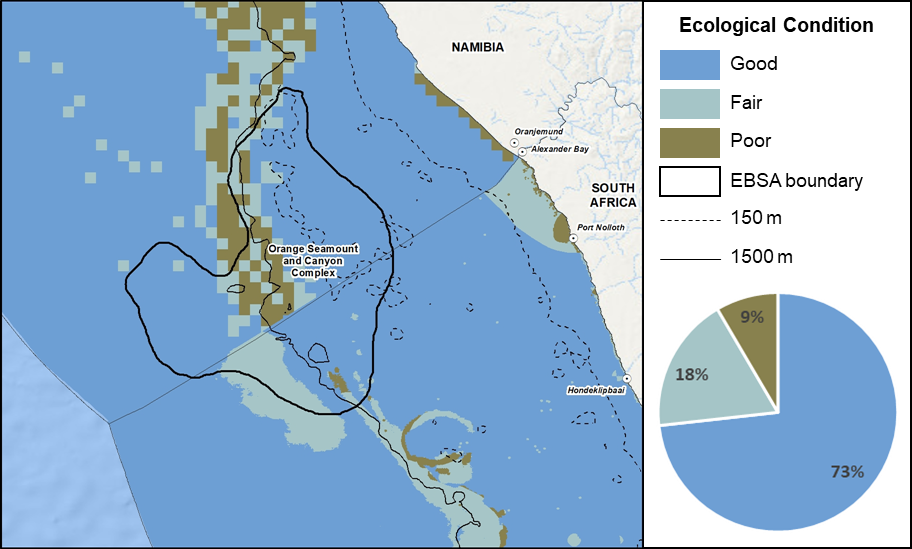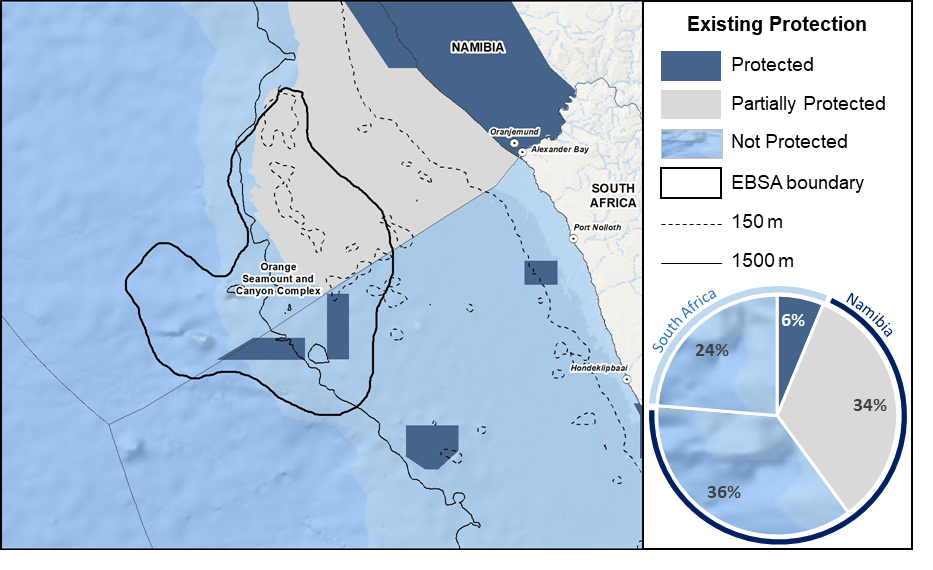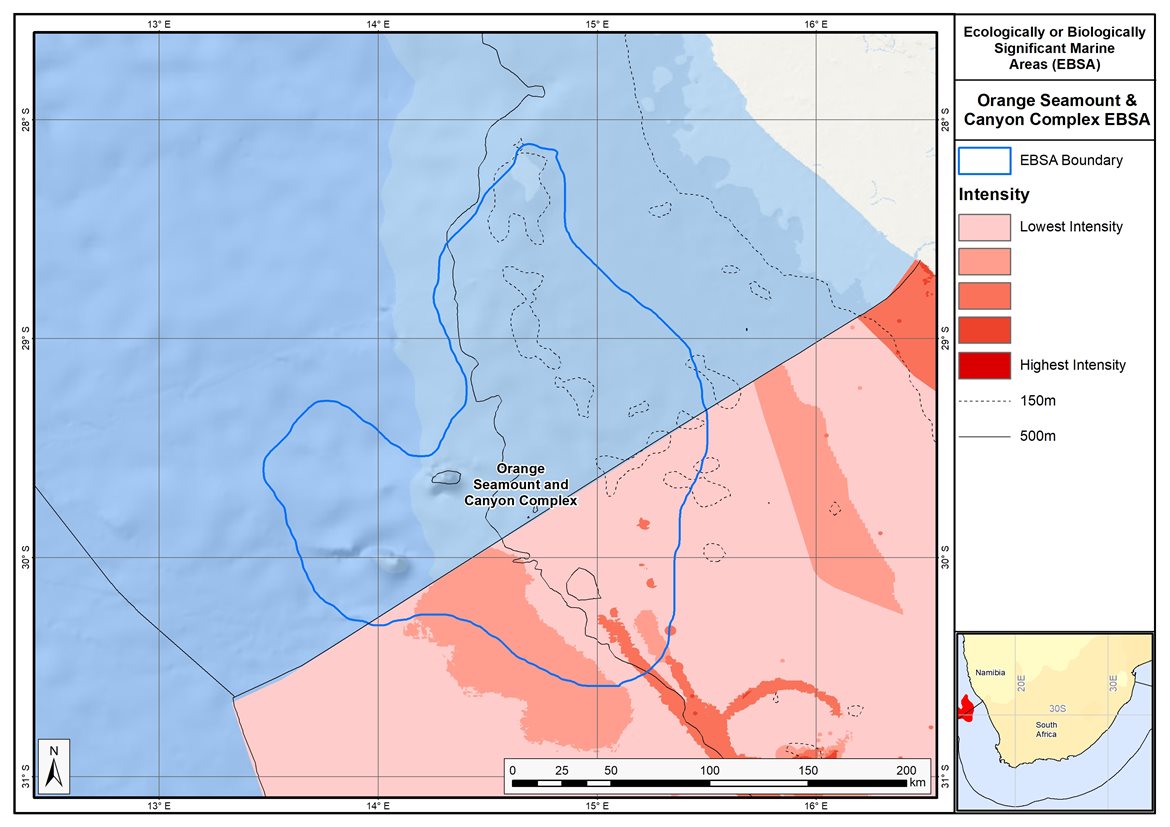|
Data used in the analyses below (ecological condition, threat status, protection, distribution of activities, cumulative pressure from activities) are from the National Biodiversity Assessment 2018: Marine Realm Assessment. See the NBA 2018 website for access to the report.
|
EBSA Status Assessment and Management Recommendations
Ecological Condition, Threat Status, Current Protection and Key Features in the EBSA
Relevant Pressures and Activities (impact, extent) | Management Interventions Needed for the EBSA
Activity Evaluation Per Zone: Zoning Feasibility | Research Needs and Future Process
Back to the SA EBSA status and management home page

Orange Seamount and Canyon Complex is an area of high habitat heterogeneity that includes Tripp Seamount and a shelf-indenting canyon. Consequently, it’s a persistent hotspot of demersal fish biodiversity. It’s at the eastern limit of the Benguela upwelling on the outer shelf, so productivity is moderate. There are three threatened ecosystem types in this area, with vast portions that are still in a natural state.
Click here for the full EBSA description
Note: Given that this is a transboundary EBSA, the status assessment is done for the EBSA as a whole, but analysis of pressures, proposed zonation and recommended management is split at the national borders to account for the differences in types of pressures and national management options, with each country responsible for EBSA management in their own jurisdiction only. This page presents the management recommendations for the South African portion of the EBSA.
[Top]
Orange Seamount and Canyon Complex has a myriad of features and ecosystem types that need to be protected for the area to maintain the characteristics that give it its EBSA status. The criteria for which this EBSA ranks highly are: importance for threatened species and habitats, biological diversity, and naturalness. There are 11 ecosystem types represented, of which the seamount, canyon and rocky shelf ecosystem types contain fragile species that are sensitive to damage. Given the high habitat heterogeneity, from the seamount to canyon, and spanning the shelf edge and slope, the site supports diverse communities and is a persistent hotspot for demersal fish. In South Africa, it’s one of the only places where two threatened ecosystem types are in a natural or near-natural state.

Orange Seamount and Canyon Complex proportion of area in each ecological condition category.
Orange Seamount and Canyon Complex is largely in good ecological condition (73%), with some portions that are in fair (18%) and poor (11%) ecological condition. Consequently, most of the area is Least Concern (81%), with some areas along the shelf edge being Endangered (10%) and Vulnerable (9%).

Orange Seamount and Canyon Complex proportion of area in each ecosystem threat status category.

Orange Seamount and Canyon Complex proportion of area in a Marine Protected Area (MPA).
Protection of features in MPAs on the South African side has been considerably expanded and strengthened following the proclamation of the Operation Phakisa MPA network, with the EBSA area within reserves increasing by an order of magnitude from no protection to 6% of the overall EBSA extent (which is 20% of the South African portion of the EBSA extent). In Namibia, the EBSA extent is split between no protection (36%) and partial protection (34%). Thus overall, 40% of the EBSA has some form of protection, and 60% is not protected. Strengthening protection in the EBSA is critical because most ecosystem types are either poorly or not protected.
Threat status, protection level and ecological condition of ecosystem types in the EBSA. Other key features are also listed.
|
Feature
|
Threat Status
|
Protection Level
|
Condition (%)
|
|
Good
|
Fair
|
Poor
|
|
Ecosystem Types
|
|
Namaqua Outer Shelf
|
LC
|
MP
|
93.8
|
6.1
|
0.1
|
|
Namaqua Shelf Edge
|
EN
|
MP
|
26.9
|
36.4
|
36.7
|
|
Namib Lower Slope
|
LC
|
NP
|
98.3
|
1.7
|
0.0
|
|
Namib Seamount
|
LC
|
NP
|
62.2
|
27.2
|
10.6
|
|
Namib Upper Slope
|
LC
|
NP
|
39.3
|
32.0
|
28.8
|
|
Southeast Atlantic Lower Slope
|
LC
|
NP
|
97.1
|
2.9
|
0.0
|
|
Southeast Atlantic Mid Slope
|
LC
|
PP
|
8.4
|
91.6
|
0.0
|
|
Southeast Atlantic Upper Slope
|
LC
|
PP
|
46.4
|
53.6
|
0.0
|
|
Southern Benguela Rocky Shelf Edge
|
VU
|
MP
|
81.1
|
0.0
|
18.9
|
|
Southern Benguela Sandy Outer Shelf
|
LC
|
PP
|
96.5
|
3.5
|
0.0
|
|
Southern Benguela Sandy Shelf Edge
|
VU
|
PP
|
95.1
|
4.9
|
0.0
|
|
Other Features
|
-
Persistent hotspot of demersal fish biodiversity
-
Canyon
-
Fragile species associated with rocky shelf edge, canyon and seamount
|
[Top]
The proposed zonation and recommended management in transboundary EBSAs is split at the national borders, with each country responsible for EBSA management in their own jurisdiction only. The sections below present the proposed management of South Africa's portion of this EBSA.
-
Five pressures are present in the South African portion of the EBSA, including: shipping, pelagic longlining, offshore trawling, benthic (hake) longlining, and tuna pole fishing. These four fisheries will need to be managed particularly well in order to protect the fragile benthic biodiversity and fish assemblages for which this EBSA is recognised. In all cases, the greater portion of each fishery is in the Impact Management Zone.
-
Pressures that don’t occur in the EBSA but are present in South Africa include: abalone harvesting, alien invasive species, beach seining, coastal development, coastal disturbance, dredge spoil dumping, gillnetting, inshore trawling, kelp harvesting, linefishing (commercial and recreational), mariculture, mean annual runoff reduction, midwater trawling, mining (prospecting and mining), naval dumping (ammunition), oil and gas (exploration and production), oyster harvesting, ports and harbours, prawn trawling, recreational shore angling, shark netting, small-pelagic fishing, south coast rock lobster harvesting, squid fishing, subsistence harvesting, wastewater discharge, west coast rock lobster harvesting; noting that some of these are coastal pressures that do not apply to offshore EBSAs.

Map of cumulative pressure from all activities in the EBSA and surrounds. Darker reds indicate higher pressure intensity.

Pressure (in arbitrary cumulative pressure units, CPUs) summed for each pressure in the EBSA, per proposed EBSA biodiversity zone, ranked left (highest) to right (lowest) by the overall relative importance of pressures in this EBSA. Note that tuna pole fishing comprises <1% of the EBSA pressure profile.
[Top]
Improved place-based protection of EBSA features should be pursued. In support of this, the EBSA is divided into a Biodiversity Conservation Zone and an Environmental Impact Management Zone, both comprising several areas within the EBSA. The aim of the Biodiversity Conservation Zone is to secure core areas of key biodiversity features in natural / near-natural ecological condition. Strict place-based biodiversity conservation is thus directed at securing key biodiversity features in a natural or semi-natural state, or as near to this state as possible. Activities or uses that have significant biodiversity impacts are incompatible with the management objective of this zone. If the activity is permitted, it would require alternative Biodiversity Conservation Zones or offsets to be identified. If this is not possible, it is recommended that the activity is Prohibited. Where possible and appropriate, the Biodiversity Conservation Zones should be considered for formal protection e.g., Marine Protected Areas or Other Effective Area-Based Conservation Measures (OECM). The aim of the Environmental Impact Management Zone is to manage negative impacts on key biodiversity features where strict place-based measures are not practical or not essential. In this zone, the focus is management of impacts on key biodiversity features in a mixed-use area, with the objective to keep biodiversity features in at least a functional state. Activities or uses that have significant biodiversity impacts should be strictly controlled and/or regulated. Within this zone, ideally there should be no increase in the intensity of use or the extent of the footprint of activities that have significant biodiversity impacts. Where possible, biodiversity impacts should be reduced.
As far as possible, the Biodiversity Conservation Zone was designed deliberately to avoid conflicts with existing activities. It also includes one MPA that is wholly within the EBSA: Orange Shelf Edge MPA. The activities permitted within this MPA are not considered as part of the EBSA management recommendations because these are as per the gazetted regulations.
Proposed zonation of the EBSA into Conservation (medium green) and Impact Management (light green) Zones. MPAs are overlaid in orange outlines, with the extent within the EBSA given in dark green. Click on each of the zones to view the proposed management recommendations.
Protection of features in the rest of the Conservation Zone may require additional Marine Protected Area declaration/expansion. Other effective conservation measures should also be applied via Marine Spatial Planning (MSP) to ensure that the existing activities/uses are appropriately controlled to ensure compatibility of activities with the environmental requirements for achieving the management objectives of the EBSA Biodiversity Conservation and Environmental Impact Management Zones.
Based on the compatibility of sea-use activities with the management objective of each EBSA zone (see table below, from the sea-use guidelines of the National Coastal and Marine Spatial Biodiversity Plan), it is recommended for MSP that compatible activities are managed as General activities, which are those that are permitted and regulated by current general rules and legislation. Activities that are conditional are recommended to be managed as Consent activities, which are those that can continue in the zone subject to specific regulations and controls, e.g., to avoid unacceptable impacts on biodiversity features, or to avoid intensification or expansion of impact footprints of uses that are already occurring and where there are no realistic prospects of excluding these activities. Activities that are not compatible are recommended to be Prohibited, where such activities are not allowed or should not be allowed (which may be through industry-specific regulations) because they are incompatible with maintaining the biodiversity objectives of the zone. These recommendations are subject to stakeholder negotiation through the MSP process, recognizing that there will likely need to be significant compromises among sectors. It is emphasized, as noted above, that if activities that are not compatible with the respective EBSA zones are permitted, it would require alternative Biodiversity Conservation Zones or offsets to be identified. If this is not possible, it is recommended that the activity is Prohibited.
List of all sea-use activities, grouped by their Marine Spatial Planning (MSP) zones, and scored according to their compatibility with the management objective of the EBSA’s Biodiversity Conservation Zone (i.e., Critical Biodiversity Area, CBA) and Environmental Impact Management Zone (i.e., Ecological Support Area, ESA). Activity compatibility is given as Y = yes, compatible, C = conditional or N = not compatible, with major activities that are present in the EBSA shaded in grey.
[Top]

Proposed zonation of the EBSA, with the cumulative intensity footprint of activities within the EBSA (sorted highest to lowest) given relative to the national footprint of those activities to illustrate feasibility of management interventions.
The EBSA includes a very small fraction of the respective national footprints of the linefisheries that are present, namely pelagic longlining, benthic (hake) longlining and tuna pole fishing, and the greater proportion of these activities is within the Environmental Impact Management Zone. These fisheries are conditionally compatible with the Biodiversity Conservation Zone and are compatible with the Environmental Impact Management Zone and therefore it is recommended that these fisheries continue in both zones provided stricter controls are put in place in the Conservation Zone. Offshore trawling is also present in a very small portion of the EBSA. This activity is not compatible with the Biodiversity Conservation Zone but is conditionally compatible in the Environmental Impact Management Zone. It is therefore recommended to continue in the Environmental Impact Management Zone provided stricter controls are put in place, and to be excluded from the Biodiversity Conservation Zone. Shipping is not managed by EBSA zones and thus is recommended to continue under current general rules and legislation. Thus, in all cases, the EBSA zonation has no or minimal impact on the activities that are present in this EBSA.
Research Needs
There are no specific research needs for this EBSA in addition to those for all EBSAs. However, it is noted that much more baseline research and ongoing monitoring is needed to ensure that the key features of the EBSA are well managed. This is particularly important because the EBSA is adjacent to Namibia’s Kudu gas field, and the area is subject to ongoing oil and gas exploration.
Future Process
There needs to be full operationalisation and practical implementation of the Orange Shelf MPA, including a management plan, staffing, and resources. There also needs to be full operationalisation and practical implementation of the proposed zoning in South Africa and Namibia’s marine spatial plans, with gazetted management regulations following the proposed management recommendations outlined above. MPA expansion within the EBSA should be explored, with relevant areas included into focus areas that can be considered further in a dedicated MPA expansion process with adequate and meaningful stakeholder engagement. Regional alignment through the BCC should continue, which could also facilitate exploration of transboundary MPAs.
[Top]